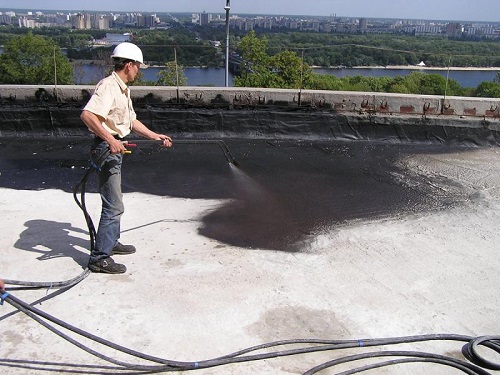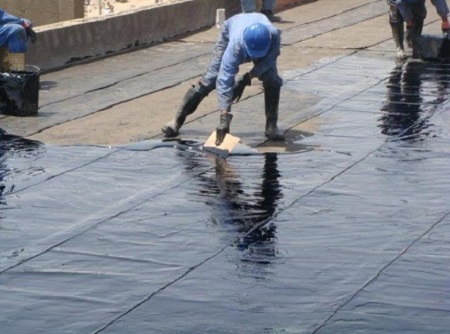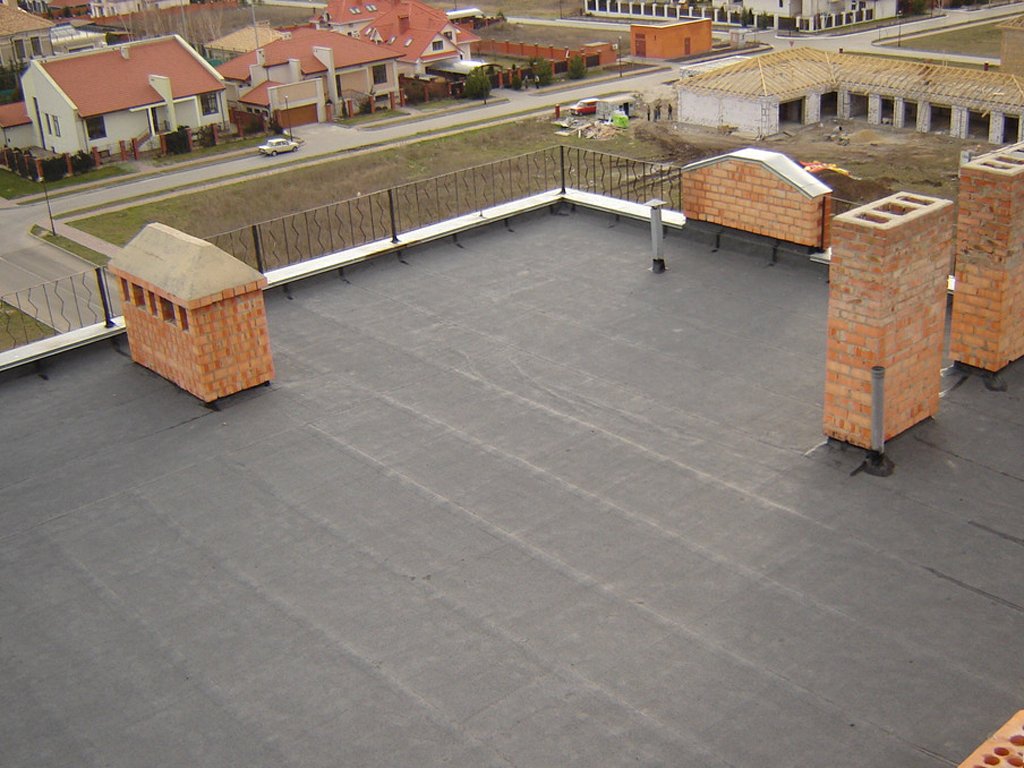Insulation of a flat roof provides for two stages of work:
- Waterproofing a flat roof.
- Vapor barrier flat roof.

But the process of these works, in turn, depends on whether the roof will be operated or not. Flat unexploited roof, unlike the exploited, does not provide a rigid base for waterproofing. In this case, a soft insulation is used. Such a roof is ideal for buildings where there is no need for maintenance of the roof and therefore any pressure is excluded. A classic non-operational roof consists of a supporting base - a metal sheet or plate - on which heat-insulating material is laid. This material, in turn, is protected from the effects of external conditions by a waterproofing carpet.
The operated roof is an improved version of a flat roof. Its difference lies in the location of the waterproofing layer not above the insulation layer, but under it. This design protects the waterproofing carpet from factors such as temperature changes, ultraviolet, freezing and thawing cycles, as well as mechanical damage.
If you reduce all the nuances that a flat roof waterproofing includes, you can get two axioms that should be taken into account at the design, construction and, of course, when installing a waterproofing:
- The surface of the flat roof should be slightly sloping. This is done so that the water drains freely and does not collect in the center.
- The waterproofing layer must be continuous, that is, cracks and gaps are unacceptable!
The fulfillment of these conditions guarantees you the quality and durability of waterproofing. It should be mentioned that flat roofs and terraces most often provide protection against water with just one waterproofing membrane. On top of everything else, you can lay a membrane with mineral sprinkling on top, or if you need to walk on the roof, pour it with concrete screed or lay tiles.
Do not forget that the waterproofing layer can be accidentally damaged during the laying of the material. This will entail the flow of water, which is difficult to detect.
The selection of materials, as well as the development of a good drainage and waterproofing system for a flat roof, require great attention and responsibility. The principles by which waterproofing should be laid can vary and depend on the estimated capabilities and the purpose of a flat roof. The only rule that must be observed in any case is that the waterproofing layer must be integral.

If there is a slight slope of the flat roof, it is advisable to build a drainage system with a strong throughput. It does not hurt to create a protective layer around the chimney (if any), the height is about 30-50 cm. This will create additional protection during periods of snow melting.
Content
Types of materials used for waterproofing
And for one, and for another type of flat roof, the waterproofing process is carried out almost identically. For this, the following roll materials are most often used:
- Polymer-bitumen.
- Roll-over.
- PVC membranes.
- Mastic materials.
Although until recently, the most popular material was roofing material. Today, it was replaced by more durable and reliable competitors.
Recently, along with bituminous materials, new polymer-bituminous ones have become increasingly popular. They are characterized by improved indicators of technical qualities, due to the strength of the reinforcing base and increased elasticity, as well as the particular qualities of the polymer-bitumen binder.
Roofing Liquid Rubber

One of the new ways of waterproofing flat roofs is roof waterproofing with liquid rubber.
Such material is very beneficial for waterproofing large roof quadratures. Roofing liquid rubber is also more convenient to use for complex reliefs of a flat roof. For example, if on the roof there are various parapets, ledges, caps, as well as pipes and antennas, then liquid rubber here will be more appropriate material than rolled bitumen materials.
Roof waterproofing with liquid rubber
Repair of a flat roof waterproofing with liquid rubber is done faster and more qualitatively than with rolled bituminous materials.
Liquid rubber is applied to the roof according to the principle of cold airless spraying. On the surface of the base, such material quickly hardens, moisture evaporates from it, after which it tightly adheres to the roof surface and takes the form of a rubber-like coating. It has such positive properties:
- Strength.
- Flexibility, elasticity.
- Absolute water resistance.
- Environmental friendliness (without solvents).
- Manufacturability (without burners, boilers).
- Reliability (service life - up to 30 years)
Stages of work when using liquid rubber for roofing
The process is divided into four stages:
- Surface preparation.
- Priming the base.
- Base reinforcement.
- Application of liquid rubber.

If you plan to repair a flat roof, then the preparatory process should be carried out necessarily! And the very first thing is cleaning the roof, since it does not make sense to bring the installation and liquid rubber onto the object where construction debris, leaves, dust, etc. are located.
Roof cleaning methods
The most effective method of cleaning the roof from dust is the use of a compressor. In this case, it is advisable to provide screens so that the dust does not blow down, but drives it to one section of the roof. And it is better that the compressor is equipped with an oil and water separator, since excess moisture on the surface that will be covered with liquid rubber is not needed.
Roof waterproofing with liquid rubber involves the process of cleaning a flat roof at the joints, junctions, and also the attachment points of various equipment (pipes, antennas, ventilation shafts). These areas are best cleaned with wire brushes with a hard and dense pile. Do not forget about the existence of special brush nozzles for the drill. They can also be useful when cleaning difficult places.
Cleaning flat roof areas is easier. Dust and dirt can be removed by rinsing with water under pressure. Various types of washing plants come in handy here. Do not forget to dry the roof surface thoroughly after this cleaning method.

If the roof has an old roll coating and if it is not removable, then it is better to do without such washing, otherwise part of the water will certainly fall under it, and this will greatly complicate the work of preparing the base for waterproofing with flat rubber.
Application of liquid rubber to fresh concrete involves the removal of cement milk. The most ideal way is grinding concrete. It consists in cutting off the upper fragile layer, due to which the pores open, which are clogged due to the primer with a bitumen-polymer emulsion. For this method, it is advisable to use concrete grinders. If there are none, then walking with brushes on the surface is at least.
What is priming

As for priming, you should know that this is spraying on the prepared surface of component “A” with the first layer. Spraying is carried out in order to create a reliable adhesion of the liquid rubber layer to the roof surface. This stage will perform a responsible function in waterproofing the roof with liquid rubber, since it is not always possible to clean the surface of dust only with the help of a water-jet installation. The primer is able to capture the smallest particles of dust that remain after treatment with a stream of water. In addition, the adhesion of the material to the surface is improved precisely due to the priming process.

If the surface is not prepared and not primed, and you have already begun to spray a layer of liquid rubber, this will be a big mistake!
Do not forget about reinforcing the roof! For some roof elements, reinforcing with geotextiles is simply necessary!
Application of liquid rubber on the roof
How is the process of waterproofing the roof with liquid rubber? It's not that complicated. During spraying, two flat flares form. Mixed with each other, they fall to the surface, and then freeze, forming a seamless waterproofing of the roof.
Liquids are a white stream - an aqueous solution of an activator and a brown - a bitumen-polymer emulsion based on water. This is liquid rubber. When the surface blackens under the influence of liquids, this means that the process of emulsion decay has already begun and a seamless membrane has formed.
Why do you need vapor barrier flat roofs?
As we already said at the very beginning of the article, in addition to the waterproofing layer, the insulation of a flat roof provides for a vapor barrier layer. Why is it needed? Its main function is to protect against the penetration of water vapor from the room into the roofing cake. If there is no vapor retardation film, then the vapor rises and there they encounter a layer of waterproofing. Over time, a considerable amount of steam can accumulate in the body of the insulation, which will lead to the loss of its thermophysical characteristics.
Selection of material for vapor barrier
There are some aspects regarding the right choice of material for vapor barrier flat roofs. The material purchased and its quantity depends on:
- Designs of the "pie" flat roof.
- Climatic conditions of construction.
- Type of roof (exploited or not).
- Way of laying on the base.
- Type of foundation.
Among the main materials for vapor barrier are the following:
- Polyethylene films.
- Polypropylene films.
- Bituminous materials.
And these are only the main ones, since there is no need to list all types of materials - today there is a huge amount of certified products of this type.

And the choice is simplified at times thanks to the principle of tabular selection. Such tables, for example, are well developed by Technonikol. At the same time, this product is today recommended by many experienced specialists, since the vapor barrier for a flat roof of TechnoNIKOL has moisture resistant and fire-fighting qualities for a long time. An advantage is its environmental friendliness.
So, we examined the main milestones of the technology of waterproofing and vapor barrier of flat roofs and found out: to achieve a high-quality membrane, as well as the reliability of all the components of the roof insulation, the work should be carried out not "for show", but "perfectly", not sparing energy, time, materials and money.





Alas, no comments yet. Be the first!